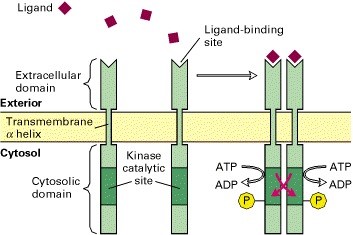Mempro™ Receptor-Type Kinase Production in Virus-Like Particles System
Creative Biostructure can provide advanced custom Mempro™ receptor-type kinase production services in virus-like particles system.
Virus-like particles (VLPs) can simulate the native virus, but are non-infectious due to they do not have any viral genetic materials. VLPs are self-assembly multiprotein structures, which are widely used in the field of vaccinology. It has proven that virus-like particles carrying conformationally-complex membrane proteins (termed lipoparticles) can be applied for integral membrane protein production. Lipoparticles can incorporate a large variety of structurally intact membrane proteins, including G protein-coupled receptors (GPCRs) and ion channels. Receptor-type kinases are the receptor proteins that include mainly receptor tyrosine kinases, and receptor serine/threonine kinases. Take receptor tyrosine kinase (RTK) as an example, a tyrosine kinase can phosphorylate tyrosine residues. It has been reported that the structure of receptor tyrosine kinase cantains a transmembrane domain, an extracellular ligand-binding domain and a cytosolic tail. The extracellular N terminal region of RTK shows a large variety of conserved elements including immunoglobulin (Ig)-like or epidermal growth factor (EGF)-like domains, fibronectin type III repeats, or cysteine-rich regions.
 Figure 1. General structure of receptor tyrosine kinases. (Mol. Cell Biol., 2000)
Figure 1. General structure of receptor tyrosine kinases. (Mol. Cell Biol., 2000)
Virus-like particles can be performed for a large variety of applications, including:
- Antibody screening;
- Phage and yeast display;
- Immunogens/vaccines production;
- Ligand binding assays;
- Nucleic acids and small molecules delivery.
- Other potential applications
Creative Biostructure offers high-quality receptor-type kinases in the stable, highly purified and native-conformation state. Lipoparticles can be generated from bacterial cells, yeast cells, insect cells, plant cells and mammalian cells for receptor-type kinase production. Well-characterized E. coli strains and insect cells are the most popularly used systems for VLPs production. Mammalian cells are also widely used for VLPs production. We can obtain lipoparticles from mammalian cells by co-expressing the retroviral structural core polyprotein, Gag, along with a desired membrane protein. Gag core proteins self-assemble at the plasma membrane, where they bud off and capture receptor-type kinases. Because of the receptor-type kinases within lipoparticles are derived directly from the cell surface without mechanical disruption or detergents, the native structure and orientation of membrane proteins are preserved.
Creative Biostructure offers other various Mempro™ membrane protein production services. Please feel free to contact us for a detailed quote.
References:
A. Roldão, et al. (2010). Virus-like particles in vaccine development. Expert Rev. Vaccines, 9(10): 1149-1176.
H. Lodish, et al. (2000). Receptor Tyrosine Kinases and Ras. Mol. Cell Biol., 4th edition. Section 20.4.
M. A. Lemmon and J. Schlessinger (2010). Cell signaling by receptor-tyrosine kinases. Cell, 141(7): 1117-1134.
P. Roy, et al. (2009). Prospects for improved bluetongue vaccines. Nat. Rev. Microbiol., 7: 120-128.
Receptor tyrosine kinase. (https://en.wikipedia.org/wiki/Receptor_tyrosine_kinase).
S. Willis, et al. (2008). Virus-like particles as quantitative probes of membrane protein interactions. Biochemistry, 47(27): 6988-6890.
Virus-like particles. (https://en.wikipedia.org/wiki/Virus-like_particle#Assembly_of_VLPs).